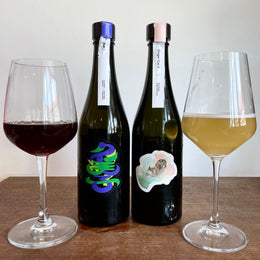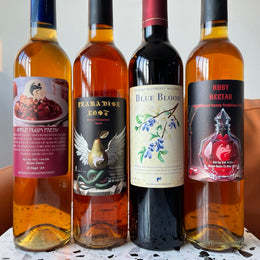
If there's only one Sherry you ought to know about - I'd argue it should be Tio Pepe.
The world of Sherry is long and storied, with a history spanning hundreds of years, even intertwining with Spanish trade history, and is of course today (perhaps somewhat unfortunately) most well-known for its use in finishing Scotch whiskies and imbuing it with those rich and decadent fruit cake, raisin, prunes, chocolate and leather flavours that has even warranted the coining of the term "Sherry Premium" when it comes to Sherry cask aged Scotch. And for the sake of posterity, I would be remiss if I didn't cast a spotlight on Sherry being a real geek's niche obsession for even the most ardent of whisky, rum and wine fans. And of course, the Spanish fortified wine is also deeply ingrained as a reliable tool that every bartender must know to use if they were to be faithfully be behind the stick. Plus it's always been a big favourite for food pairings by chefs from fine dining establishments all the way to the local tapas place. You could say Sherry really has range.


Sherry's got range!
And indeed it does! Today, the world outside of Spain is probably most familiar with just two styles of Sherry - Pedro Ximenez and Oloroso - both of whom leans towards darker and heavier flavours. And yet the true spectrum of Sherry goes all the way from the lighter Manzanilla and Fino, towards the more middleweight Amontillado and Oloroso, before getting on to the heavier Pedro Ximenez (with Pale Cream and Cream somewhere in the middle as a blend of multiple Sherry styles). The traditional way in which Sherry is aged is also something of a perennial fascination to the drinks community - with bodegas leveraging the Solera method of stacking barrels of Sherry with each successive lower level of barrels increasingly more aged. Each time Sherry is drawn from the barrel, younger Sherry from the layer of barrels above is poured downwards to top up a lower (and more aged) layer of barrels - it works almost like a waterfall system.

And with so much going on, Sherry remains an incredibly distinctive and unique class of fortified wine that is truly of its own, whilst being incredibly versatile and of course tasty - and for that reason, is so incredibly underrated even today! I suppose it comes down to the lack of big budget marketing and the complexity of its traditional processes that remains opaque to its fans-to-be.
Which is why if there's at least one Sherry you ought to know about - it really has to be Tio Pepe.
Now Tio Pepe, which typically goes for less than US$20 anywhere in the world, is hardly the apex of Sherry-making, but what it is is incredibly great value for money, affordable, easily accessible and you can find it almost anywhere, and ridiculously versatile whether you want to have it neat, pair it with food, cook with it or make cocktails with it, Tio Pepe is your guy.

It is the quintessential Sherry that is the gateway to the world of Sherry.
And now that I've made my case, who is Tio Pepe?
Tio Pepe - whose real name is Jose Angel - was a man who was pivotal to the success of one of the Sherry giants of today, Gonzalez Byass. Gonzalez Byass is today the largest Sherry maker, producing a range of Sherry from its over 650 hectares of prime Sherry vineyards in the Jerez Superior area within southwestern Spain's Sherry triangle.
This all started in 1835, when a 23 year old Manuel Maria Gonzalez had started a small Sherry business from a little rented warehouse in the centre of old Jerez. It was there that he had begun ageing his first casks of Sherry. During a fateful trip to England, Gonzalez would meet a wine importer by the name of Robert Blake Byass. Together they would form the company Gonzalez Byass, with Manuel producing the Sherry in Spain, and Robert importing and distributing it in Britain.

Yet, it was ultimately Manuel's uncle, Jose Angel, who also went by the nickname "Tio Pepe" for "Uncle Joe", who had provided the business much needed Sherry-making expertise, having been himself somewhat of a Sherry expert.
And thus the Tio Pepe Fino Sherry was born, beginning its export around the world from 1844. The Tio Pepe bottle is recognisable beyond its label as it sports a now iconic guitar player for a logo, which was designed in the 1920's in a bid to capture the Andalucian sensibilities of the brand. Today Tio Pepe is by far the most admired Sherry expression in the world, and is amongst the best selling.

With numerous Sherry styles, what then goes into Tio Pepe?
Tio Pepe is made 100% from the wine of Palomino Fino grapes, which comes specially from the chalk rich soils of Macharnudo and Carrascal in Jerez, where the soil is known as Albariza, and is renown for its ability to maintain moisture through the prolonged hot and dry summers of Spain, allowing the grapes to grow without irrigation. The area also has a microclimate that is characterised by its exposure to the surrounding Atlantic Ocean, which gives the area a moist and cool wind from the sea, which fights against the hot and dry wind coming from north Africa. The humidity in the area is high and annual rainfall can range up to 600 litres per square metre. This exposes the grapes to intense weather variations.

The Gonzalez Byass vineyards - notice the white chalky soils!
Once harvested, the Palomino grapes are sorted for must quality, after which light pressure is applied to allow its juices to flow freely. After fermentation is complete, the wine is then fortified, bringing its alcohol level from 11-12%, up to 15.5%. The fortified wine is then entered into the Tio Pepe Solera where it will age in the Jerez cellars. During which - and this is crucial to its flavours - some empty space is left in the cask that allows for a layer of yeast to coat the exposed surface of the wine, known as "flor". This protects the wine from oxidation and is what gives Sherry its nutty and yeasty, umami flavours. The Sherry then spends at least 4 years ageing under the flor layer before it is eventually bottled as Tio Pepe.

Finally before we get to tasting it neat, it's worth talking about how Tio Pepe can be best enjoyed.
Typically it is to be enjoyed chilled in a small wine glass, and is said to be ideally paired with seafood, particularly fish, as well as umami rich foods like nuts, olives, cured meats and even sushi. It can also be enjoyed with some ice tossed in, or even with some 7-Up soda added in which is said to be how locals like to enjoy it. In a cocktail, Tio Pepe would be most commonly used in a Dirty Martini.
And now, let's go!
Review: Tio Pepe Fino Sherry

Tasting Notes
Colour: Straw
Aroma: Incredibly aromatic and evocative, it has a very intense and rich bouquet that almost radiates out of the glass. It's rather buttery of brioche, salted butter, sea spray, along with big notes of nuttiness of almonds and walnuts, it sort of combines with the richness and butteriness to give marzipan. Some candied orange peels outlining the nose, with some gentle but bright notes of green apples too. There's a yeasty quality of soft brie cheeses, along with this mustiness of cold subterranean stone cellars.
Taste: It's immediately creamy, but also noticeably dry, it's not even slightly sweet. Instead it's savoury and salty, like salted almonds and green olives. Served cold, it's really crisp and fresh, with the richness almost curtailed. More of that marzipan, yeastiness of brie cheese rinds, with a slight bit of grapefruit acidity.
Finish: That citrusy acidity and salinity pushes through, like salty kipper fishes served in olive oil with some lemon zest drizzled over it. It's a long finish, the richness hits a few seconds in, incredibly fresh in the aftertaste, with just a slight aromatic quality of lemons.

My Thoughts
No matter how many times you have a glass of Tio Pepe, it always hits the spot - it's crisp, it's fresh, it's rich and also has a good but not overpowering umami quality to it. It's perfectly balanced between sporting some rancio notes of nuttiness and yeastiness, along with some citrusy streaks to lift it up, and has also a saltiness to it that also serves to brighten it up, and then holding it all together is this rich creaminess that is at the same time not at all sweet. It's at once complex yet approachable, fresh and rich yet not heavy or sweet, with some umaminess that adds dimensions to it without being too strong.
And whilst Tio Pepe is very enjoyable on its own, I'd still say it's ultimate best use is in pairing it with food or in a dirty martini where it really just elevates the entire experience and brings so much to the table in its complementary flavours. Next time you're headed to a nearby tapas joint, ask for a glass of Tio Pepe, or heck, bring it to your next sushi meal - guaranteed to blow your top off. And it's wallet friendly and pretty much available at any grocery store. This is your public service announcement to try some Sherry today - trust me, the bounty of folks who obsess about it know what you're missing.
Kanpai!

@111hotpot







